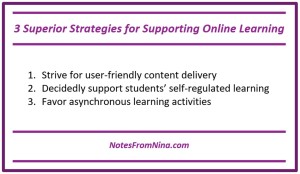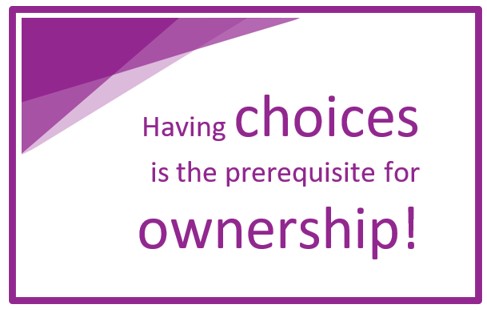Learning happens in interactions. It is not an event, but an ongoing process (Stahl et al., 2010). Online learning presents great opportunities for individual and productive learning interactions. therefore learning experience design should be built around intereactions. Obviously, there may be some serious problems, too, such as not noticing when students are struggling. Most problems get solved when we focus on supporting students’ learning process and build our communications around that support.
When we consider the first part of learning process to be interactions between the learner, content, and environment, and the second part being internal acquisition and elaboration (Illeris, 2003, p. 398), it seems obvious that the core strategies for great online education focus on supporting these two processes. I have found the following three superior strategies to be the most helpful ones during the last 8 years of my online practice.
- Strive for user-friendly content delivery – make it easy for students to know what to do and where to find necessary information.
- Decidedly support students’ self-regulated learning – the learning process is very individual and we can help students to design better learning experiences for themselves.
- Favor asynchronous learning activities – we want to differentiate students learning experiences, and accommodate differnet needs and previous knowledge with asynchronous activities.
Learning is such a personal experience. When our students have successful learning experiences they are more likely to want to learn more. The three strategies above agree with the framework of Teacher’s Pedagogical Knowledge (Sonmark, et al., 2017), addressing all three areas of our necessary professional competence: Instructional Process (teaching methods, lesson planning and classroom management), Learning Process (learning & development and dispositions), and Assessment (evaluation and diagnosis procedures & data and research literacy). More about the strategies below!

First strategy: make learning easier by providing choices for engaging with the content. Curriculum usually dictates the content to be learned. Delivering content is the easiest problem to solve while transferring to online learning. We can share documents and record presentations, provide worksheets and self-assessments. It is important to honor students’ different preferences for obtaining information, some prefer watching videos, others like to read or listen. Keep videos short. Make sure to provide a transcript for a video or podcast – especially when instructing adults. We read much faster than anyone can talk.
Often online learning includes using a Learning Management System, LMS. As educators we have to become proficient users of the LMS, in addition to the foundational competencies of Teachers’ Pedagogical Knowledge, otherwise online teaching becomes very cumbersome. Obviously, students have different previous exposure to online environments, so remembering to offer help for navigation is the crucially important first step. Series of walk through documents or short videos is better than one or two long videos. We want to be sure to provide just-in-time support to make it easy for students to navigate the syllabus and their learning materials.
Online learning environment can sometimes become a barrier for learning. Therefore, it is important to step out of our own comfort zone with the LMS, and try to see it with the eyes of someone who encounters it for the first time. Are learning materials organized in a user-friendly way? Does the navigation make implicit sense to a person who encounters it for the first time? How can we help all students to navigate their new learning environment? These questions are equally important if we are just providing the learning materials over a website. In situations with great learner diversity it may be best to create a checklist for required activities and another list for additional supporting documents. And, most importantly: make sure to be willing and available to help.
Second strategy: Support self-regulated learning (Zimmerman, 2000). The greatest mistake while switching to online learning is the attempt of mimicking seat-based education where instructor talks and students sit and listen (an approach created without modern knowledge of how learning happens and how it can best supported). First rule of effective education is this: learning process is individual – so, focus your efforts on supporting students’ learning process. While we all DO learn the same way, through acquisition and elaboration, our concept development and preferred constructs for connecting new information to our existing knowledge are very diverse. We all have our own mental models of the world and keep adding information to our own knowledge base. Information that is not personally assimilated or accommodated will simply be forgotten, as it doesn’t become a part of our knowledge structure. Therefore, supporting students’ learning process and being available to answer questions IS the path for effective online education.
Self-regulated learning cycle guides students through the three crucial parts of learning: Planning – Performance – Reflection. The planning phase (forethought) includes analyzing the tasks and setting the process and completion goals. Planning for our own learning is an advanced skill, and we cannot expect students to master it immediately. Providing support for planning is crucially important in the beginning!, because students may not have any experience of designing their own learning experiences. The performance phase relies on self-monitoring, so that we are aware of our own learning process and can compare it to the expected outcomes. Rubrics are the best possible formative assessment tool for online learning, because they show students the criteria for grading. The use of rubrics in formative assessments has been shown to support students’ learning in recent educational research (eg. Panadero, Jonsson & Botella, 2017; Kasimatis, Kouloumpis, & Papageorgiou, 2019; Ajjawi, Bearman & Boud, 2019). The third phase of learning process also relies on rubrics because looking back to the choices made in the current cycle, and having an open dialogue about choices for the next learning cycle, is the very moment for effective self-regulated learning to emerge. Engaging in individual discussions about the rubric with each student is easier in the online learning environment than in the classroom. It can be a chat or a phone/webcam discussion with online collaboration over the documents comparing the rubric and student’s performance. The important part for the instructor is to listen and learn more about how the student thinks, to best support them during the next learning cycle. The planning part in the next learning cycle benefits from the foundation a dialogue provides. So, make sure to be available to help.
The third strategy: favoring asynchronous learning is great! We all learn in different pace, depending on our previous knowledge and thinking patterns. Learning doesn’t happen like manufacturing items on a conveyor belt. Learning process has spurts and halts, and sometimes looping back to already learned content is necessary, because we need to review or relearn things. The great thing about online learning is that we all can take as much time as we need to complete a learning activity – and students don’t have to feel bored or anxious because they need more or less time for the task than others. Yes, there can and should be times when the whole class checks in, or when a sub task must be ready for a small group assignment. But it doesn’t mean everyone have to sit still if they have already completed it, they can go for a short walk before engaging the next session, or do something else to invigorate themselves. Encouraging students to take several short breaks during the day is very important. I still believe that Finnish model of taking a 15-minute break after every 45-minute lesson was a great way to keep my students engaged and ready to learn. Favoring asynchronous learning activities allows us to support students’ individual needs. So, make sure to be available to help.
Bottom line: Online education has the potential to become students’ best or worst learning experience. We can make it to become the best one, by adapting practices that focus on supporting each individual student’s learning process. Therefore, make sure to be available to help.
😊
Nina
Ajjawi, R., Bearman, M., & Boud, D. (2019). Performing standards: a critical perspective on the contemporary use of standards in assessment. Teaching in Higher Education, 1-14.
Illeris, K. (2003). Towards a contemporary and comprehensive theory of learning. International journal of lifelong education, 22(4), 396-406.
Kasimatis, K., Kouloumpis, D. & Papageorgiou, T. (2019). Cultivation of 21st-century skills: Creating and implementing rubrics for assessing projects. New Trends and Issues Proceedings on Humanities and Social Sciences. [Online]. 6(7), pp 180-188. Available from: www.prosoc.eu
Panadero, E., Jonsson, A., & Botella, J. (2017). Effects of self-assessment on self-regulated learning and self-efficacy: Four meta-analyses. Educational Research Review, 22, 74-98.
Stahl, S. M., Davis, R. L., Kim, D. H., Lowe, N. G., Carlson, R. E., Fountain, K., & Grady, M. M. (2010). Play it again: the master psychopharmacology program as an example of interval learning in bite-sized portions. CNS spectrums, 15(8), 491-504.
Sonmark, K. et al. (2017), “Understanding teachers’ pedagogical knowledge: report on an international pilot study”, OECD Education Working Papers, No. 159, OECD Publishing, Paris. http://dx.doi.org/10.1787/43332ebd-en
Zimmerman, B. J. (2000). Attaining self-regulated learning: a social-cognitive
perspective, in M. Boekaerts, P. Pintrich, and M. Zeidner (Eds.) Handbook of Self-regulation (pp. 13–39). San Diego, CA: Academic Press.
Tags: Deep Learning, empowering, Learning Design, learning environments, learning facilitation, Learning Process, pedagogy, SEL

 Dialogue involves multiple dimensions of the classroom reality. Working with the tensions that occur in classroom setting is important to make dialogue possible. Having a non-punitive assessment system is important for fostering dialogue in the classroom. Risk-taking behaviors are not likely to happen in a learning environment where students get punished for submitting a “wrong answer”. Right and wrong, true and false, are dichotomies that belong to more objectivist pedagogy and official knowledge, and thus are destructive for collaborative meaning-making.
Dialogue involves multiple dimensions of the classroom reality. Working with the tensions that occur in classroom setting is important to make dialogue possible. Having a non-punitive assessment system is important for fostering dialogue in the classroom. Risk-taking behaviors are not likely to happen in a learning environment where students get punished for submitting a “wrong answer”. Right and wrong, true and false, are dichotomies that belong to more objectivist pedagogy and official knowledge, and thus are destructive for collaborative meaning-making.







